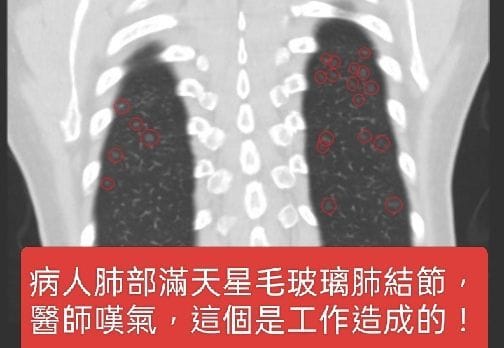Woman Found with “Starry Sky” Lung Nodules—Doctor Sighs: Caused by Her Job
A woman’s lungs covered with glass nodules reveal the hidden dangers of long-term exposure to industrial solvents like toluene in shoemaking workplaces.

Introduction: The Starry Sky Inside Her Lungs 🌌
Imagine going in for a routine health checkup and discovering your lungs look like a "starry sky" on a CT scan. This bizarre and alarming image was the reality for a 60-year-old woman whose lungs were dotted with dozens of ground-glass nodules. Doctors were puzzled at first but soon uncovered an unsettling cause hiding in plain sight: her job in the shoemaking industry.
The Silent Threat of Toluene Exposure
Toluene, an organic solvent commonly found in paints, glues, and industrial processes, silently invaded her lungs over years of work. This chemical, although invisible and often underestimated, can wreak havoc on the respiratory system when inhaled repeatedly. In her case, the long-term exposure likely led to widespread lung inflammation, manifesting as those haunting ground-glass nodules.
Dr. Su Yifeng (蘇一峰), the treating thoracic physician, sighed as he unraveled the mystery. Occupational lung disease related to solvents like toluene is not uncommon but often overlooked or misdiagnosed. These findings raise important questions about workplace safety standards and the necessity for thorough exposure histories during medical evaluations.
More Than Just Lungs: The Broader Impact of Toluene
Toluene’s harm doesn’t stop at lung tissue. It can depress the central nervous system causing symptoms like dizziness, headaches, and memory issues. Chronic exposure risks irreversible nerve damage, vision and hearing disorders, and even liver and kidney damage. The gravity of these effects begs the question: Are workplaces doing enough to shield workers from such dangers? 🤔
Prevention Is Better Than Cure: Protecting Workers
Simply wearing a mask isn’t enough in these environments. Stronger safeguards like solvent-resistant gloves, protective clothing, and proper ventilation systems are essential. Regular monitoring of solvent concentrations in the workplace can help enforce safe exposure limits and prevent cases like this one from becoming more common.
The woman's story acts as a stark reminder to both employers and employees: ignoring these hazards isn't just risky—it can silently etch a starry sky in your lungs.
Conclusion: A Call for Awareness and Action
While the pattern of lung nodules in this case is rare and visually striking, the underlying issue is widespread and concerning. This raises critical questions about the adequacy of worker protections, the need for more rigorous industrial health regulations, and the importance of doctors’ investigative efforts to identify occupational causes behind complex lung diseases.
Her case isn’t just an isolated medical curiosity—it’s a vivid warning sign flashing in the dusty air of countless factories and workshops worldwide.




